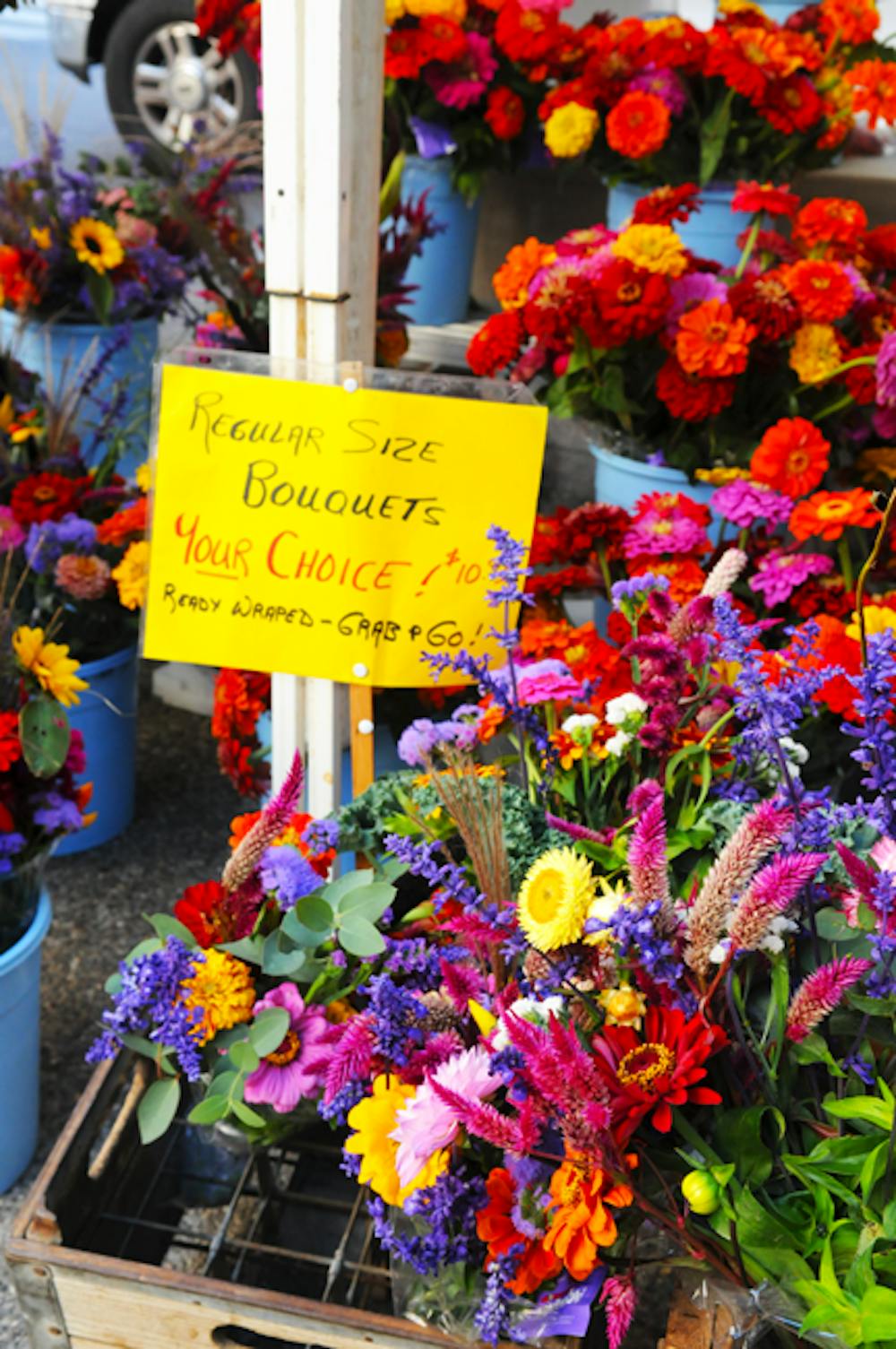If you take a walk in Philadelphia on any Saturday morning in September, you’re bound to run into a farmers’ market. You know you’re getting close if you pass someone with a reusable shopping bag in one hand and a dog leash in the other. Round a corner and there it is: a row of square white tents, queued on the sidewalk, maybe edging a park or a patch of green, maybe just parked along the street.
The city’s biggest and busiest farmers’ market — and probably its most visible — is at Rittenhouse Square, beginning at 19th St. and stretching down Walnut before wrapping around to 18th. The Rittenhouse market boasts 30 vendors who hawk everything from pumpkins and herbal teas to apricot jam and raw goat's milk. There is a stall that sells ostrich eggs and another that specializes in canelés, a type of French pastry with a caramelized crust and a custard center. There’s a company peddling homemade hummus and one, called Urban Apiaries, advertising honey with the memorable slogan, “We turn flowers into gold!”
Despite the seeming ubiquity of farmers’ markets, their presence in Philly is a recent phenomenon. 20 years ago, there were no farmers’ markets here, no merchants peddling crates of squash or Mennonite farmers offering apples by the pound within metropolitan limits. There are a number of reasons for Philadelphia’s shift from fresh food desert to urban–oasis–in–the–making — this century’s “green” craze among them — but a lot of it comes down to one man: Bob Pierson.
Dubbed the “Father of Philadelphia’s Farmers’ Markets” by the Philadelphia Inquirer in April, Pierson helped to establish seven of Philly’s first farmers’ markets while working for the Food Trust, a non–profit that brings local produce to low–income areas. He left in 2000 to found Farm To City, a company that connects local farmers with local customers. It currently operates 16 markets, including those at Rittenhouse and the Penn Bookstore. In 2008, Farm to City was named a regional Small Business of the Year by the U.S. Small Business Administration. In its first year, the profits from Farm To City’s markets came in at around $150,000. This year, their sales tipped the scales at more than $2 million.
At 72, Pierson is lean and wiry, with closely–cropped white hair and kind eyes. When he’s out in the sun at one of his markets, he favors rolled–up shirtsleeves and a straw panama hat. In the early 90s, working as an environmental consultant, Pierson was inspired by a lone vendor who sold organic produce at a small table in Reading Terminal Market. He began looking for ways to turn his vision of neighborhoods dotted with locally–sourced food stalls into a living reality. His first farmers’ market opened at South and Passyunk in 1996.
Dr. Janet Chrzan, who is a nutritional anthropologist and an old friend of Pierson’s, says Pierson was instrumental in helping to publicize and implement the idea of the “outdoor, one–day–a–week farmers' market” in Philadelphia. Before this movement began in the 90s, she says, “that model was one that had fallen out of favor for many American cities. It was something that was considered old–fashioned and not viable.”
Pierson’s work isn’t, at its fundamental core, about enriching the city or its citizens. Instead, it’s about supporting Pennsylvania and New Jersey farmers and saving their lands from suburban sprawl in the process. Everything else flows outward from that main mission. Pierson’s father was the first director of parks in Bucks County, and Pierson cites his father’s wisdom when describing his own goals: “You can’t save farmland unless you save the farmers.” The farmers are Pierson’s clients, not the shoppers. He and his company are the farmers’ defenders, advocates and guardians.
“In the early years,” Pierson says, “it was hard to find vendors. I’d spend a lot of time around February and March on the phone at dinnertime, just calling these long lists of farmers.” Farmers were reluctant to come into a city that, though it was mere miles away, seemed a foreign place. They were content to continue relying on the gamble of produce auctions, where, on a bad day, they could end up losing money because the fruit they’d brought to sell was so marked–down that it was worth less than the boxes that contained it. Small family–owned farms trying to compete in the commodity crop market faced even tougher economic conditions. Chrzan says, “[Local] farmers cannot make a living by selling vegetables to wholesalers. They cannot compete with foods grown in Mexico and Costa Rica.” Local farmers couldn’t keep up with larger, industrialized operations that were designed with the sole purpose of churning out corn, soy or wheat in enormous quantities.
Pierson’s determination paid off because his idea made sense. Farmers could set their own prices. Customers benefited from easy access to fresher, tastier food. Word spread as “the adventuresome” first farmers found success, and more farmers followed. These days, Farm To City has to turn potential vendors away because there is not enough demand to accommodate all of them. In its efforts to assist and promote local farmers’ interests, Farm To City now also runs community supported agriculture programs, or CSAs, as well as Winter Harvest, a buying club that allows city residents to purchase local produce in the months when most farmers’ markets are dormant.
So why should we shop at farmers’ markets? Why does eating local matter? “It’s food security,” Pierson says. “You want to be close to the people who supply your food, because then you have more influence on what they do.” In Pierson’s opinion, too many Americans depend on processed foods for nutrition, inadvertently supporting giant food corporations that typically trade in less–than–savory environmental and ethical business practices. As Dr. Chrzan points out, it’s to our advantage to protect local farmers, because without them our region can’t feed itself. Buying local at a farmers’ market is a way to get to know your food by getting to know the farmer who grew it.
There are other benefits, too, according to Pierson: “If it’s fresher it tastes better. It may be more healthful. Environmentally, the carbon footprint should be a lot less because it’s not going over these long distances that the world food supply goes over. The farms are typically small family farms and they typically take better care of their land…It strengthens the regional economy and rural culture.”
This all sounds great, but there are limits to farmers’ markets’ reach, especially in a city like Philadelphia, where 26.7% of the population was classified as poor by the Pew Trusts in 2012. “We’ve tried to do farmers’ markets half a dozen times in low–income areas. And it’s not a good fit,” Pierson says. The problem is that farmers tend to be low–income themselves, and they cannot afford to sell at the prices that people living at or below the poverty line are able to pay. According to Pierson, Americans have, across the socioeconomic spectrum, lost essential kitchen skills and the cooking know–how that used to be passed down from generation to generation. With the advent of cheap, pre–packaged dinners and readily available fast food, many Americans don’t know what to do with fresh fruit and vegetables from a farmers' market. This issue is exacerbated in low–income neighborhoods because people there are often working multiple jobs and commuting long distances. They don’t have the time to regularly cook meals from scratch. But Farm To City hasn’t given up trying to confront this challenge. It is partnering with the Philadelphia Housing Authority again this season, after a failed attempt last year, to provide what Pierson calls “an affordable package of food…particularly for low–income housing.”
Bob Pierson is still on his way to realizing the version of Philadelphia he imagined back in 1996, where farmers are paid fairly for their goods and city dwellers reject processed foods in favor of fresh, local produce. There's still a lot of work to be done.
Penn students are part of a larger regional community. Whether students choose to acknowledge it or not (and Bob Pierson would much rather they did), their dietary decisions have repercussions that echo far beyond the narrow borders of Penn’s campus. Opting for a Honeycrisp apple from an orchard within 100 miles of campus instead of a shrink–wrapped baggie of apple slices from a grocery store is not just good for you — it’s also good for Philadelphia. Even undergraduates on Bon Appetit's dining plans can eat seasonal and regional ingredients in Commons and Houston Hall, such as mushrooms from Kennett Square, PA or tomatoes and from Vineland, NJ.
If you stop by Rittenhouse this Saturday, you’ll probably see moms in gym clothes, pushing strollers and toting blocks of cheese and bundles of straw flowers, along with guys in cargo pants holding jars of Lancaster County honey, talking politics with the neighbors. You might not see Bob Pierson — these days, a Farm to City staff member oversees the market’s weekly opening — but you’ll know that without him, it’s possible that none of it would be there.
---
Kiley Bense is a senior from Devon, PA. She is studying English and edits the Music section of 34th Street.







